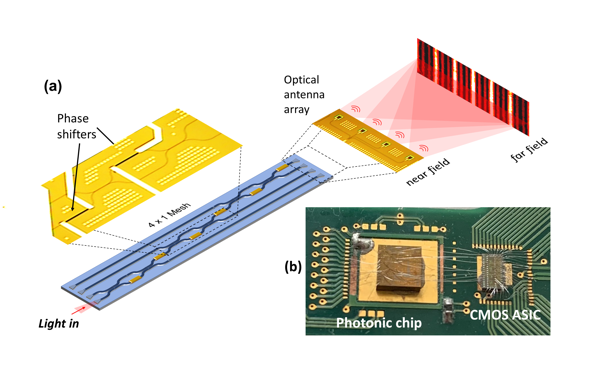Optics in free space is a long-established, traditional branch of optics. One might expect only incremental advances in this field by now. Actually, nothing could be further from the truth. In a world where devices are ever more connected, exchanging massive amounts of data, free-space optics (FSO) is being deeply reconsidered, and is returning to the leading edge of optics research.
New generations of optical systems for localization, positioning, and ranging, as well as artificial vision and imaging, are likely to appear soon in autonomous vehicles, drones and in portable devices like smart glasses. In all these applications, the light has to be generated, manipulated, and controlled with high-speed devices with the smallest footprint, weight, power consumption, and cost.
The shaping of optical beams with suitable amplitude, phase, and polarization features across the beam cross-section – "structured light" – is not a new concept; it has already been used in high resolution imaging, microscopy, particle detection, and communications. Traditionally, the light is manipulated using bulk optics, such as lens systems. More recently spatial light modulators (SLMs) have added flexibility and reconfigurability. However, SLMs can be large and expensive, and are typically programmed only at relatively low frame rates (e.g., a few hundred Hz). They can modify the phase of light, but less readily control amplitude or polarization efficiently. Their operation can require advanced interferometric calibration techniques and optimization algorithms whose computational complexity scales up strongly with the pixel count.
For such beam-shaping, programmable photonic circuits can be a game changing technology. Such circuits consist of generic reconfigurable architectures made of meshes of tunable integrated interferometers, which can be arranged either in feed-forward or recursive topologies. Because they can implement arbitrary linear transformations, they have already been employed in a variety of applications, including programmable filters for microwave photonics, unmixing of guided modes in spatial division multiplexing (SDM) communications, vector-matrix multiplication and computing, quantum information processing, and artificial neural networks.
The research led by Prof. Francesco Morichetti and Prof. Andrea Melloni from Politecnico di Milano, in collaboration with Prof. David Miller from Stanford University, shows that integrated programmable photonic circuits can also open new avenues in the generation, manipulation and detection of FSO beams. The research results are published in Photonics Research, Vol. 9, No. 11, 2021 (Maziyar Milanizadeh, Fabio Toso, Giorgio Ferrari, et al. Coherent self-control of free-space optical beams with integrated silicon photonic meshes[J]. Photonics Research, 2021, 9(11): 11002196).
In this work, they use a programmable mesh of Mach–Zehnder interferometers (MZIs) [Fig 1(a)], fabricated on a small silicon chip (2.8 mm by 0.5 mm), to control the optical field radiated and captured by an array of optical antennas. Thanks to the remarkable flexibility of this programmable mesh, a number of functionalities are demonstrated that go well beyond those of ordinary optical phased arrays. For example, since the amplitude and the phase of the light emitted by each antenna can be individually controlled, "perfect" desired beams can be generated even if the antennas are imperfect because of fabrication variations.
Further, the light beam can be automatically shaped or "pre-compensated" to give a desired pattern at the receiver, even when obstacles in the free space link introduce wave-front distortion or scattering. The tuning procedure for the mesh does not require any prior information on the nature of the obstacle, and the resulting tuned settings can effectively be used for the identification and recognition of unknown obstacles in the FSO path. Because the MZI mesh can generate any output amplitudes and phases, obstacles with arbitrary amplitude and phase profile can be recognized. For example, we could imagine readout systems for multilevel (amplitude and phase) bar codes.
Furthermore, such programmable photonic circuits can self-configure; remarkably simple algorithms enable the MZIs in the mesh find their optimum setting automatically. Here, each MZI is controlled by a local feedback loop, a strategy that dramatically reduces the control complexity compared to the more typical global multivariable optimization techniques required by other approaches to manipulating or correcting FSO beams. As shown in Fig. 1(b), the photonic chip is wire-bonded to a CMOS ASIC; this ASIC integrates the front-end electronics for the readout of the chip's integrated power monitors, and provides the feedback control for the phase shifters (thermal tuners) of the tunable MZIs.

Fig.1 (a) Programmable photonic mesh employed for the control the optical field radiated by an array of four optical antennas. (b) The photonic chip is wire bonded to a CMOS ASIC that hosts the electronics for the readout of the on-chip power monitors and the voltage drivers of the integrated thermal tuners.
Thanks to its parallel implementation, such self-configuration can be scaled up to circuits with many optical antennas, enabling capabilities well beyond ordinary optical phased arrays. Such efficient self-configuration also allows dynamic tracking of time-varying changes in the FSO link – for example, from the presence of particles or atmospheric turbulence – thus maintaining an optimum communication channel.
Finally, the implementation of the programmable photonic circuit on a standard silicon photonic platform enables integration with many other devices for functions like wavelength filtering, (de)multiplexing, and fast time-domain modulations, thus enabling implementation of sophisticated and advanced all-optical processing of FSO beams.


